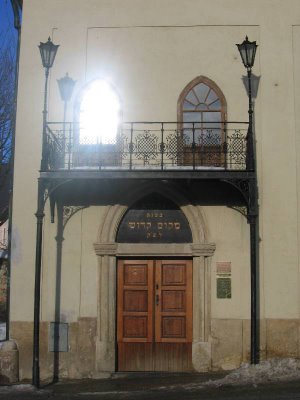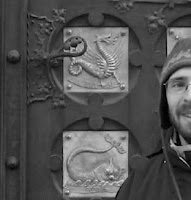After the Ples Was Over
28 February 2006 Another one from the archives, this time even farther back.
Another one from the archives, this time even farther back.January and February are ples season. (The season is at its end, as Lent begins.) In many Czech cities and towns, a ples (basically a fancy dress ball) is a popular event in the post-Christmas and pre-Lent winter months. These seem to be fun ways to lighten up the dreary weather and to get warm in the frigid winter months.
On Saturday 21 January, I went to the Reprezentační ples ("Society Ball") sponsored by the Brno Philharmonic. This was the eleventh annual ball sponsored by the orchestra. This year was particularly significant as the orchestra is celebrating the fiftieth anniversary of its founding. (A special jubilee concert on 1 January 2006 marked the official anniversary with the performance of Beethoven’s "Lenore" Overture and Ninth Symphony.)
The ball was held in the Besední dům, the orchestra’s official home and rehearsal space. The neo-renaissance building is on the north-west corner of the Koliště, Brno’s ring-road. It was designed by the "Viennese architect of Danish origin" Theophil Hansen and built between 1871 and 1873. The interior of the hall mimics Vienna's Musikverein, which was also designed by Hansen and built between 1867 and 1870. The comparative scale of the two buildings shows Brno's position as a provincial capital rather than a center of the empire: while the Besední dům's hall is fairly large, it could easily fit inside the Great Hall (Großer Saal) of the Musikverein. The rest of Brno’s ring road and the buildings lining it were are also closely linked to Viennese Ringstrasse concept. It is at times difficult to see this comparison directly since Brno is much smaller than Vienna, but there is definitely a likeness in concept and intent, though perhaps not in execution and scale.
Besední dům was intended as a cultural center for Brno. Though not originally as the seat of the philharmonic, it has always been a center for musical activities. During a student demonstration in 1905, the worker F. Pavlík was shot and killed in the square outside the building; this event caused nationalistic sentiment to rise among Brno’s Czech population and also was the impetus of Janáček’s piano sonata 5.XI.1905. Other buildings on the ring road include the Kounic Palace (currently the administration building of Masaryk University), the Janáček Theater (1964) and the Mahen Theater (both house companies of the National Theater in Brno), the functionalist Zeman coffee house, and the main train station.
Of my Prague friends, only Karla was able to make it. We were both curious to find out what was involved in the ples phenomena. Things started off with a program of light dance music by the philharmonic. The classics of this genre are by the Viennese Strausses; Johann was well-represented. There was also some Smetana (polkas) and the waltzes and polonaise from Tchaikovsky’s Eugene Onegin. Then the ples proper started. An MC announced that the first dance would be a waltz played by the philharmonic. The orchestra’s President and his wife were to lead the dancing, followed by four other select couples (I guess they knew who they were), and then the rest of us could join. This was followed by a polka by Smetana (played a bit too slowly) and then another waltz. It was impressive to see the formally dressed couples circling the floor of the hall. Since the space was designed as a social center, the current concert hall can easily convert into a ballroom (the chairs are removable). The surroundings—seven gilded chandeliers, an organ, the cream and gold nymphs and swans holding up the ceiling, and the full orchestra—gave the impression of glamour and nineteenth-century pomp. Some people may criticize Brno for a lack of luxury and grandeur, but they are obviously looking in the wrong places.
There was a short break after the orchestra finished before the jazz band and cimbalom band began. We ordered a glass of wine for our table (well, it was just the two of us), some peanuts, and then some pretzels. The music following the orchrestra had considerably fewer pretensions. The jazz band was live, but seemed to be modeled after the Glenn Miller concept and played mostly hits of the 1930s, 40s, and perhaps a few from the 50s. These were good for dancing. A second group played the best of the 1980s and 90s (yes, I’m being euphemistic here) with beautiful Casio synthesizers and a (real human!) singer. It seemed to us that their performance was a bit too much like a high school prom, so we did not dance much during this portion. It was certainly popular with many of the other attendees. There was also a tombola (raffle) between two of the later sets. Anyone who has seen Miloš Forman’s film, Hoří, má panenko (Firemen’s Ball, 1967) could appreciate this. A man near us won five (5) prizes!
There was also cimbalom music. This was the main reason I wanted to come to the ples in the first place. My teacher, Dalibor Štrunc, and his band performed downstairs in the bar for those who were tired of dancing and needed some refreshement. Karla and I were disappointed that there was not much dancing. It seemed that people came down to sing or have a glass of wine rather than to dance. At one point Petr Altrichter, the orchestra’s artistic director and conductor came out (he seemed to be on his way home). I was videotaping from the back, and of course he proceeded to stand directly in my line of sight. It was obvious that he greatly enjoyed the music and he even sang in the raucous, half-drunk style that is characteristic of some Moravian music. The cimbalom band was certainly a highlight of the evening.
 The variety of balls that take place during the winter months is also surprising. This billboard from Velké Bílovice features advertisements for a firemen's ball, a children's ball, a ball of folk costumes, a wine ball, and more!
The variety of balls that take place during the winter months is also surprising. This billboard from Velké Bílovice features advertisements for a firemen's ball, a children's ball, a ball of folk costumes, a wine ball, and more!




 A graduate student in music and anthropology writing a dissertation about music in Moravia, the eastern third of the Czech Republic. At some point, the Czech Republic's "second city" (that would be Brno) captured my attention, and I've since been blogging about events, arts, music, and other stuff—basically whatever interests me in and around the cityscape. I'm not living in Brno now, but I keep up with the cultural pulse from afar as best I can.
A graduate student in music and anthropology writing a dissertation about music in Moravia, the eastern third of the Czech Republic. At some point, the Czech Republic's "second city" (that would be Brno) captured my attention, and I've since been blogging about events, arts, music, and other stuff—basically whatever interests me in and around the cityscape. I'm not living in Brno now, but I keep up with the cultural pulse from afar as best I can.

